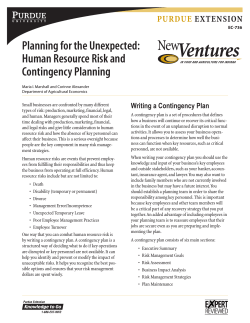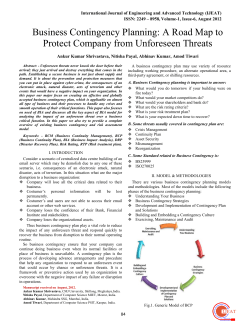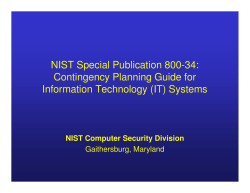
SAMPLE IT CONTINGENCY PLAN FORMAT
Attachment I
SAMPLE IT CONTINGENCY PLAN FORMAT
This sample format provides a template for preparing an information technology (IT)
contingency plan. The template is intended to be used as a guide, and the Contingency Planning
Coordinator should modify the format as necessary to meet the system’s contingency
requirements and comply with internal policies. Where practical, the guide provides instructions
for completing specific sections. Text is added in certain sections; however, this information is
intended only to suggest the type of information that may be found in that section. The text is
not comprehensive and should be modified to meet specific agency and system considerations.
The IT contingency plan should be marked with the appropriate security label, such as Official
Use Only.
1
Attachment I
IT CONTINGENCY PLAN
1. INTRODUCTION
1.1 PURPOSE
This {system name} Contingency Plan establishes procedures to recover the {system name}
following a disruption. The following objectives have been established for this plan:
•
•
•
•
Maximize the effectiveness of contingency operations through an established plan that
consists of the following phases:
Notification/Activation phase to detect and assess damage and to activate the plan
Recovery phase to restore temporary IT operations and recover damage done to the
original system
Reconstitution phase to restore IT system-processing capabilities to normal operations.
Identify the activities, resources, and procedures needed to carry out {system name}
processing requirements during prolonged interruptions to normal operations.
Assign responsibilities to designated {Organization name} personnel and provide guidance
for recovering {system name} during prolonged periods of interruption to normal operations.
Ensure coordination with other {Organization name} staff who will participate in the
contingency planning strategies. Ensure coordination with external points of contact and
vendors who will participate in the contingency planning strategies.
1.2 APPLICABILITY
The {system name} Contingency Plan applies to the functions, operations, and resources
necessary to restore and resume {Organization name}’s {system name} operations as it is
installed at primary location name, City, State. The {system name} Contingency Plan applies to
{Organization name} and all other persons associated with {system name} as identified under
Section 2.3, Responsibilities.
The {system name} Contingency Plan is supported by plan name, which provides the purpose of
plan. Procedures outlined in this plan are coordinated with and support the plan name, which
provides purpose of plan.
1.3 SCOPE
1.3.1 Planning Principles
Various scenarios were considered to form a basis for the plan, and multiple assumptions were
made. The applicability of the plan is predicated on two key principles:
•
•
The {Organization name}’s facility in City, State, is inaccessible; therefore, {Organization
name} is unable to perform {system name} processing for the Department.
A valid contract exists with the alternate site that designates that site in City, State, as the
{Organization name}’s alternate operating facility.
2
Attachment I
{Organization name} will use the alternate site building and IT resources to recover
{system name} functionality during an emergency that prevents access to the original
facility.
The designated computer system at the alternate site has been configured to begin
processing {system name} information.
The alternate site will be used to continue {system name} recovery and processing
throughout the period of disruption, until the return to normal operations.
1.3.2 Assumptions
Based on these principles, the following assumptions were used when developing the IT
Contingency Plan:
•
•
•
•
•
•
•
•
The {system name} is inoperable at the {Organization name} computer center and cannot be
recovered within 48 hours.
Key {system name} personnel have been identified and trained in their emergency response
and recovery roles; they are available to activate the {system name} Contingency Plan.
Preventive controls (e.g., generators, environmental controls, waterproof tarps, sprinkler
systems, fire extinguishers, and fire department assistance) are operational at the time of the
disaster.
Computer center equipment, including components supporting {system name}, are connected
to an uninterruptible power supply (UPS) that provides 45 minutes to 1 hour of electricity
during a power failure.
{system name} hardware and software at the {Organization name} original site are
unavailable for at least 48 hours.
Current backups of the application software and data are intact and available at the offsite
storage facility.
The equipment, connections, and capabilities required to operate {system name} are
available at the alternate site in City, State.
Service agreements are maintained with {system name} hardware, software, and
communications providers to support the emergency system recovery.
The {system name} Contingency Plan does not apply to the following situations:
•
•
•
Overall recovery and continuity of business operations. The Business Resumption Plan
(BRP) and Continuity of Operations Plan (COOP) are appended to the plan.
Emergency evacuation of personnel. The Occupant Evacuation Plan (OEP) is appended to
the plan.
Any additional constraints should be added to this list.
1.4 REFERENCES/REQUIREMENTS
This {system name} Contingency Plan complies with the {Organization name}’s IT contingency
planning policy as follows:
The organization shall develop a contingency planning capability to meet the needs of
critical supporting operations in the event of a disruption extending beyond 72 hours. The
3
Attachment I
procedures for execution of such a capability shall be documented in a formal contingency
plan and shall be reviewed at least annually and updated as necessary. Personnel
responsible for target systems shall be trained to execute contingency procedures. The plan,
recovery capabilities, and personnel shall be tested to identify weaknesses of the capability at
least annually.
The {system name} Contingency Plan also complies with the following federal and departmental
policies:
•
•
•
•
•
•
•
•
•
The Computer Security Act of 1987
OMB Circular A-130, Management of Federal Information Resources, Appendix III,
November 2000
Federal Preparedness Circular (FPC) 65, Federal Executive Branch Continuity of Operations,
July 1999
Presidential Decision Directive (PDD) 67, Enduring Constitutional Government and
Continuity of Government Operations, October 1998
PDD 63, Critical Infrastructure Protection, May 1998
Federal Emergency Management Agency (FEMA), The Federal Response Plan (FRP), April
1999
Defense Authorization Act (Public Law 106-398), Title X, Subtitle G, “Government
Information Security Reform,” October 30, 2000
Any other applicable federal policies should be added
Any other applicable departmental policies should be added
1.5 RECORD OF CHANGES
Modifications made to this plan since the last printing are as follows:
Page No.
Record of Changes
Change Comment
Date of Change
Signature
2. CONCEPT OF OPERATIONS
2.1 SYSTEM DESCRIPTION AND ARCHITECTURE
Provide a general description of system architecture and functionality. Indicate the operating
environment, physical location, general location of users, and partnerships with external
organizations/systems. Include information regarding any other technical considerations that
are important for recovery purposes, such as backup procedures. Provide a diagram of the
architecture, including security controls and telecommunications connections.
4
Attachment I
2.2 LINE OF SUCCESSION
The {organization name} sets forth an order of succession, in coordination with the order set
forth by the department to ensure that decision-making authority for the {system name}
Contingency Plan is uninterrupted. The Chief Information Officer (CIO), {organization name}
is responsible for ensuring the safety of personnel and the execution of procedures documented
within this {system name} Contingency Plan. If the CIO is unable to function as the overall
authority or chooses to delegate this responsibility to a successor, the Deputy CIO shall function
as that authority. Continue description of succession as applicable.
2.3 RESPONSIBILITIES
The following teams have been developed and trained to respond to a contingency event
affecting the IT system.
The Contingency Plan establishes several teams assigned to participate in recovering {system
name} operations. The {team name} is responsible for recovery of the {system name} computer
environment and all applications. Members of the team name include personnel who are also
responsible for the daily operations and maintenance of {system name}. The team leader title
directs the {team name}.
Continue to describe each team, their responsibilities, leadership, and coordination with other
applicable teams during a recovery operation.
The relationships of the team leaders involved in system recovery and their member teams are
illustrated in Figure XX below.
(Insert hierarchical diagram of recovery teams. Show team names and leaders; do not
include actual names of personnel.)
Describe each team separately, highlighting overall recovery goals and specific responsibilities.
Do not detail the procedures that will be used to execute these responsibilities. These
procedures will be itemized in the appropriate phase sections.
3. NOTIFICATION AND ACTIVATION PHASE
This phase addresses the initial actions taken to detect and assess damage inflicted by a
disruption to {system name}. Based on the assessment of the event, the plan may be activated by
the Contingency Planning Coordinator.
In an emergency, the {Organization name}’s top priority is to preserve
the health and safety of its staff before proceeding to the Notification
and Activation procedures.
5
Attachment I
Contact information for key personnel is located in Personnel Contact list appendix. The
notification sequence is listed below:
•
•
•
The first responder is to notify the Contingency Planning Coordinator. All known
information must be relayed to the Contingency Planning Coordinator.
The systems manager is to contact the Damage Assessment Team Leader and inform them of
the event. The Contingency Planning Coordinator is to instruct the Team Leader to begin
assessment procedures.
The Damage Assessment Team Leader is to notify team members and direct them to
complete the assessment procedures outlined below to determine the extent of damage and
estimated recovery time. If damage assessment cannot be performed locally because of
unsafe conditions, the Damage Assessment Team is to follow the outline below.
Damage Assessment Procedures:
(Detailed procedures should be outlined to include activities to determine the cause of
the disruption; potential for additional disruption or damage; affected physical area and
status of physical infrastructure; status of IT equipment functionality and inventory,
including items that will need to be replaced; and estimated time to repair services to
normal operations.)
Upon notification from the Contingency Planning Coordinator, the Damage
Assessment Team Leader is to …
The Damage Assessment Team is to ….
Alternate Assessment Procedures:
Upon notification from the Contingency Planning Coordinator, the Damage Assessment
Team Leader is to …
The Damage Assessment Team is to ….
− When damage assessment has been completed, the Damage Assessment Team Leader
is to notify the Contingency Planning Coordinator of the results.
− The Contingency Planning Coordinator is to evaluate the results and determine
whether the contingency plan is to be activated and if relocation is required.
− Based on assessment results, the Contingency Planning Coordinator is to notify
assessment results to civil emergency personnel (e.g., police, fire) as appropriate.
The Contingency Plan is to be activated if one or more of the following criteria are met:
1. {System name} will be unavailable for more than 48 hours; or
2. Facility is damaged and will be unavailable for more than 24 hours; or
3. Other criteria, as appropriate.
•
•
If the plan is to be activated, the Contingency Planning Coordinator is to notify all Team
Leaders and inform them of the details of the event and if relocation is required.
Upon notification from the Contingency Planning Coordinator, Team Leaders are to notify
their respective teams. Team members are to be informed of all applicable information and
prepared to respond and relocate if necessary.
6
Attachment I
•
•
•
The Contingency Planning Coordinator is to notify the off-site storage facility that a
contingency event has been declared and to ship the necessary materials (as determined by
damage assessment) to the alternate site.
The Contingency Planning Coordinator is to notify the Alternate site that a contingency
event has been declared and to prepare the facility for the Organization’s arrival.
The Contingency Planning Coordinator is to notify remaining personnel (via notification
procedures) on the general status of the incident.
4. RECOVERY OPERATIONS
This section provides procedures for recovering the application at the alternate site, whereas
other efforts are directed to repair damage to the original system and capabilities.
The following procedures are for recovering the {system name} at the alternate site. Procedures
are outlined per team required. Each procedure should be executed in the sequence it is
presented to maintain efficient operations.
Recovery Goal. State the first recovery objective as determined by the Business Impact
Assessment (BIA). For each team responsible for executing a function to meet this objective,
state the team names and list their respective procedures.
•
•
•
{team name}
− Team Recovery Procedures
{team name}
− Team Recovery Procedures
{team name}
− Team Recovery Procedures
Recovery Goal. State the second recovery objective as determined by the BIA. For each
team responsible for executing a function to meet this objective, state the team names and list
their respective procedures.
•
•
•
{team name}
− Team Recovery Procedures
{team name}
− Team Recovery Procedures
{team name}
− Team Recovery Procedures
Recovery Goal. State the remaining recovery objectives (as determined by the BIA). For
each team responsible for executing a function to meet this objective, state the team names
and list their respective procedures.
5. RETURN TO NORMAL OPERATIONS
This section discusses activities necessary for restoring {system name} operations at the
{Organization name}’s original or new site. When the computer center at the original or new
7
Attachment I
site has been restored, {system name} operations at the alternate site must be transitioned back.
The goal is to provide a seamless transition of operations from the alternate site to the computer
center.
Original or New Site Restoration
Procedures should be outlined, per necessary team, to restore or replace the original site so
that normal operations may be transferred. IT equipment and telecommunications
connections should be tested.
•
•
{team name}
− Team Resumption Procedures
{team name}
− Team Resumption Procedures
5.1 CONCURRENT PROCESSING
Procedures should be outlined, per necessary team, to operate the system in coordination with
the system at the original or new site. These procedures should include testing the original or
new system until it is functioning properly and the contingency system is shut down gracefully.
•
•
{team name}
− Team Resumption Procedures
{team name}
− Team Resumption Procedures
5.2 PLAN DEACTIVATION
Procedures should be outlined, per necessary team, to clean the alternate site of any equipment
or other materials belonging to the organization, with a focus on handling sensitive information.
Materials, equipment, and backup media should be properly packaged, labeled, and shipped to
the appropriate location(s). Team members should be instructed to return to the original or new
site.
• {team name}
− Team Testing Procedures
• {team name}
− Team Testing Procedures
6. PLAN APPENDICES
The appendices included should be based on system and plan requirements.
• Personnel Contact List
• Vendor Contact List
• Equipment and Specifications
• Service Level Agreements and Memorandums of Understanding
8
Attachment I
•
•
•
•
•
•
IT Standard Operating Procedures
Business Impact Analysis
Related Contingency Plans
Emergency Management Plan
Occupant Evacuation Plan
Continuity of Operations Plan.
9
© Copyright 2025

















